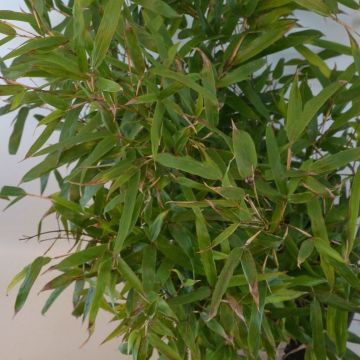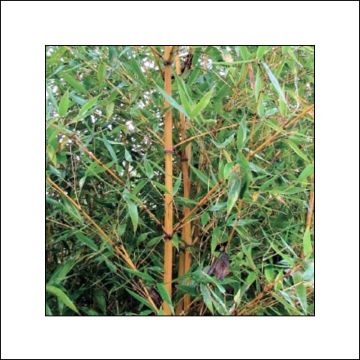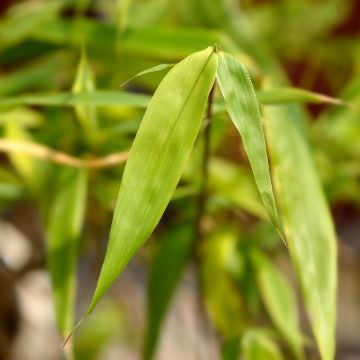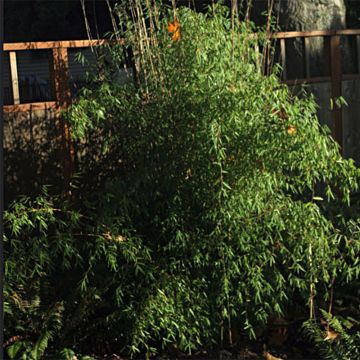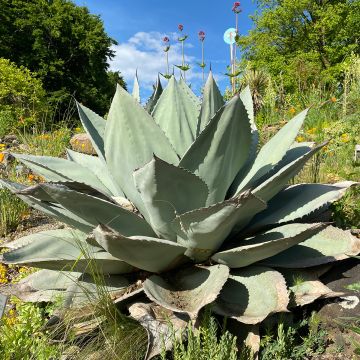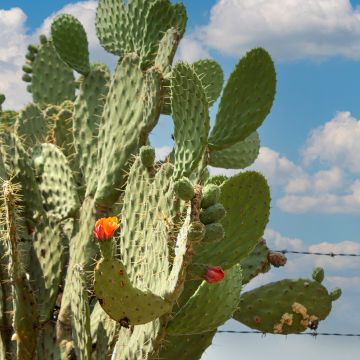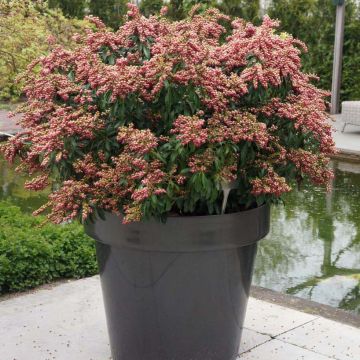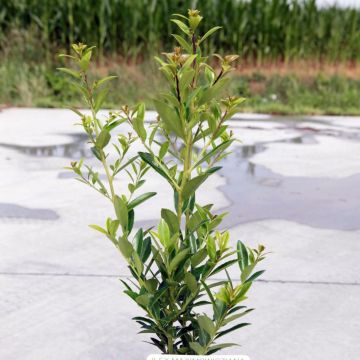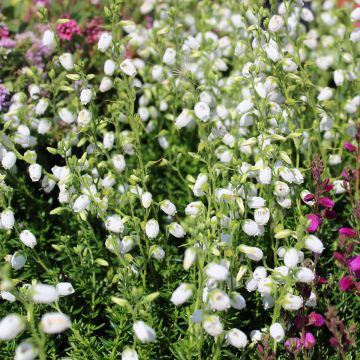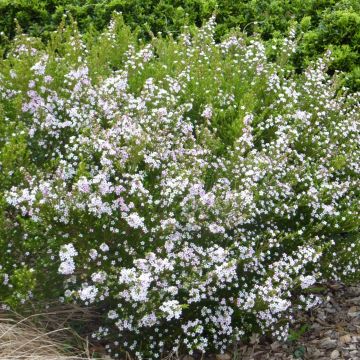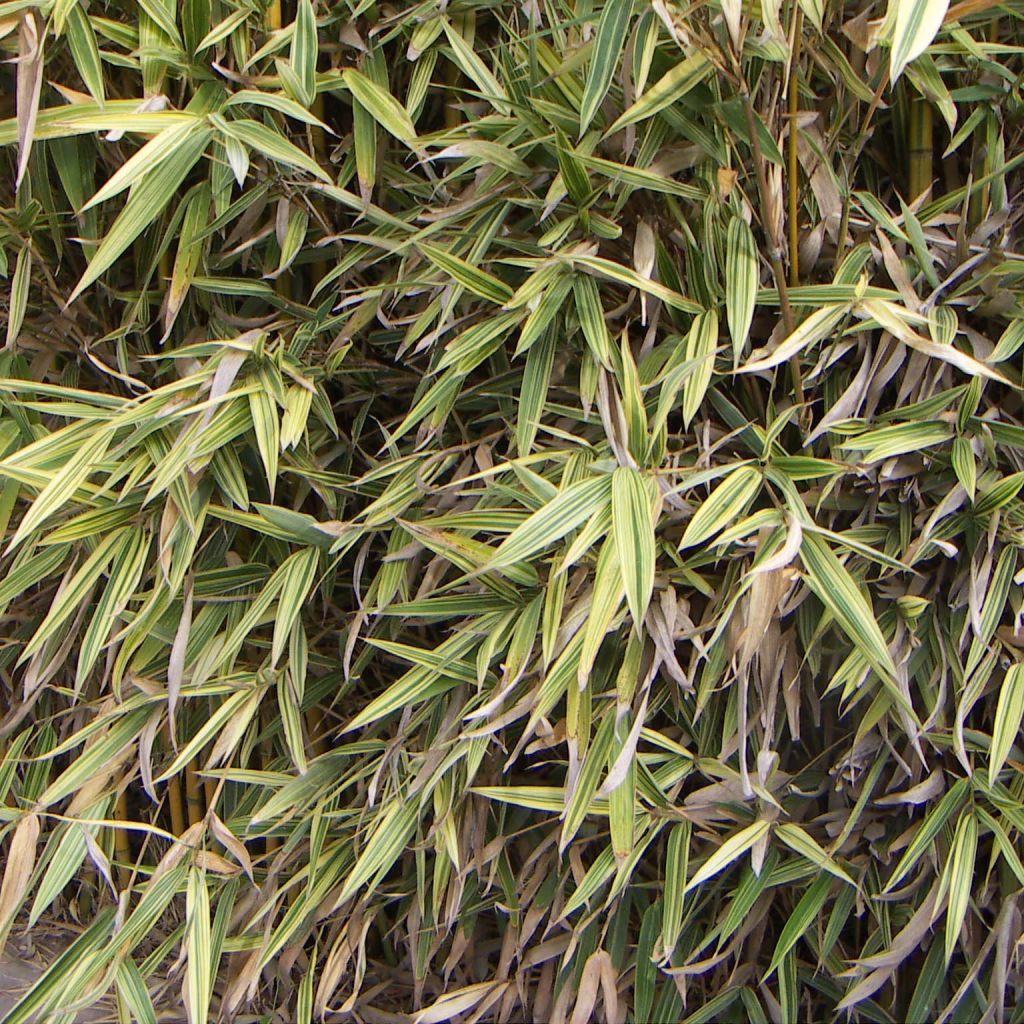

Hibanobambusa tranquillans Shiroshima
Hibanobambusa tranquillans Shiroshima
Hibanobambusa tranquillans Shiroshima
Shiroshima Bamboo
This item cannot be shipped to the selected country
Delivery charge from €5.90
More information
Schedule delivery date,
and select date in basket
This plant carries a 24 months recovery warranty
More information
We guarantee the quality of our plants for a full growing cycle, and will replace at our expense any plant that fails to recover under normal climatic and planting conditions.
From €5.90 for pickup delivery and €6.90 for home delivery
Express home delivery from €8.90.
Does this plant fit my garden?
Set up your Plantfit profile →
Description
The Hibanobambusa tranquillans Shiroshima is undoubtedly one of the most beautiful small variegated foliage bamboos, its long light green leaves strongly striped with white cream are as bright as they are luminous throughout the year. Of modest stature, upright but bushy and very dense, this bamboo combines the qualities of its two parents, combining the beautiful foliage of the Sasa with the thicker culms of the Phyllostachys. Resistant to cold, tolerant to drought and indifferent to exposure, it is easy to grow in all areas. 'Shiroshima' allows you to create a beautiful and effective windbreak hedge and is also suitable for planting as a solitary plant in a small garden. However, its spreading character requires the installation of a rhizome barrier.
The Hibanobambusa tranquillans, sometimes called Hibano Bamboo, is a plant of the poaceae family, a type of grass with woody stems that develops from a trailing rhizomatous stump. In this type of bamboo, the rhizomes develop at the periphery of the stump, which rapidly expands to cover the area over vast spaces. The Hibanobambusa tranquillans is probably the result of a spontaneous crossbreeding that took place in Japan. This hybrid bamboo is one of the most robust, it can withstand temperatures of around -18 to -20°C and is not very demanding in terms of soil or exposure.
The Shiroshima cultivar, introduced in Europe in the 1970s, was selected for its variegated foliage and more compact growth. The plant has an upright and bushy habit. Its growth is quite fast, developing solid and straight culms, also known as culms, from its rhizomes. They measure about 1 to 2 cm (0.4 to 0.8 in) in diameter, and can reach 2 to 3 m (6 ft 7 in to 9 ft 10 in) in height depending on the growing conditions, a potted plant will grow less than one planted in the ground. The culms are smooth and green in colour, sometimes slightly striped with white cream. The sheaths that cover the young stems are brown and deciduous. The foliage is abundant and evergreen: it remains bright even when the winter is cold and dry. In this bamboo, the leaves are twice as long and wide on the current year's culms as on the previous year's culms. The variegated leaves are tapered at their tips, measuring 15 to 20 cm (5.9 to 7.9 in) in length and 4 to 5 cm (1.6 to 2 in) in width, slightly trailing. Particularly variegated in winter, they are adorned with a pink border in spring.
A star of Asian-inspired gardens, bamboo suits many styles, from contemporary to exotic, including natural gardens, Zen gardens, or water gardens. When planted en masse, Hibano Bamboo quickly creates a very dense screen or a charming small forest, its density brings lushness to any setting. The obscuring power of its foliage and its rapid growth make it an excellent candidate for hiding an unsightly view or creating an effective windbreak. Its presence is such that you can plant it as a solitary specimen, leaving enough space for it to express its generosity. However, its spreading character requires maintaining a certain distance from neighbouring plants that it tends to overwhelm. The cultivation of Hibanobambusa Shirishima is possible in pots but not recommended in the long term, again due to its spreading nature.
Report an error about the product description
Hibanobambusa tranquillans Shiroshima in pictures
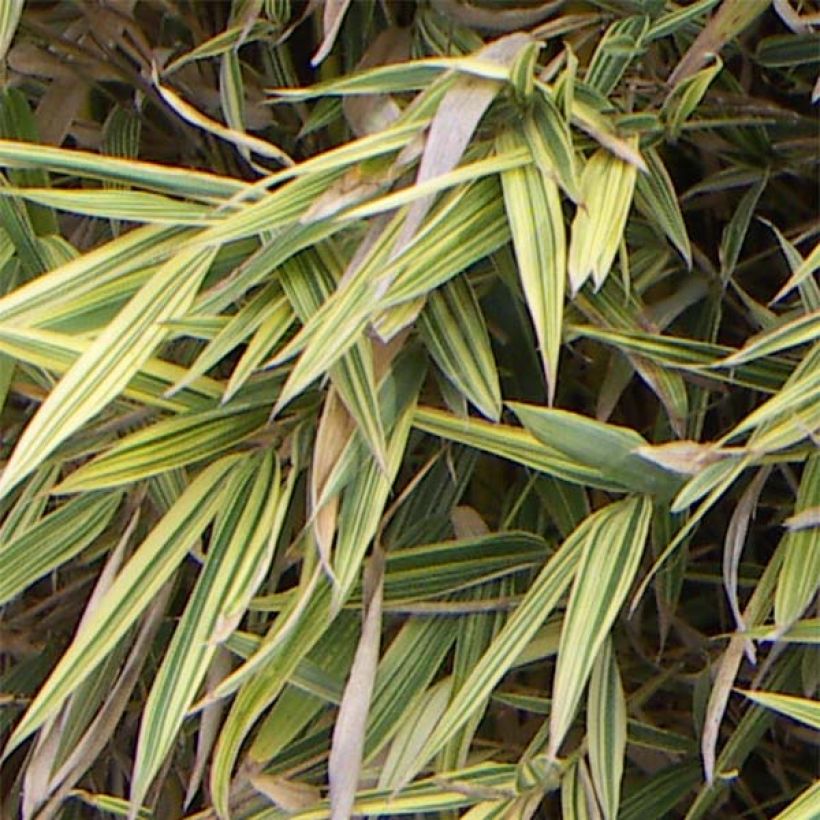

Plant habit
Foliage
Botanical data
Hibanobambusa
tranquillans
Shiroshima
Poaceae
Shiroshima Bamboo
Southeast Asia
Other Bamboos A to Z
Planting and care
Cultivated in containers, bamboo can be planted at any time of the year, except during freezing conditions. However, the best planting period is late summer and autumn, when the soil is warm and rainfall is more frequent. The planting distance depends on how you plan to use your bamboos: for a mass planting, leave a gap of 0.8 to 1 metre (2 feet 7 inches to 3 feet 4 inches) between each plant. For a hedge, this distance can be reduced to 0.6 to 0.8 meters (2 to 2 feet 7 inches).
In general, bamboos prefer deep, rich, well-drained soil that remains moist, either acidic or neutral. They can tolerate slightly limestone soil, depending on the variety. The Hibanobambusa bamboo is particularly tolerant of the soil, as long as it is not excessively limestone or too heavy. It prefers sunny exposures in the north of our country, but more shaded areas in the south. It withstands moderate periods of drought, but will struggle without any water for 3 months in a very dry climate.
During planting, make sure to loosen the soil and thoroughly moisten the root ball by soaking it. You can add well-rotted compost and mix it into the surface. Watering should be done regularly, at least during the first year if planted in the ground, and continuously if your bamboos are grown in pots. The establishment period may sometimes seem a bit long, but don't panic!
This bamboo is spreading, so it is highly recommended to install a rhizome barrier (thick and resistant polypropylene film).
In terms of maintenance, bamboo is not demanding: remember to weed around the base, at least in the beginning until its dead leaves, left on the ground, form a natural mulch. A nitrogen fertiliser (well-rotted manure or liquid fertiliser) in spring and autumn can be beneficial.
Planting period
Intended location
Care
This item has not been reviewed yet - be the first to leave a review about it.
Evergreen shrubs
Haven't found what you were looking for?
Hardiness is the lowest winter temperature a plant can endure without suffering serious damage or even dying. However, hardiness is affected by location (a sheltered area, such as a patio), protection (winter cover) and soil type (hardiness is improved by well-drained soil).

Photo Sharing Terms & Conditions
In order to encourage gardeners to interact and share their experiences, Promesse de fleurs offers various media enabling content to be uploaded onto its Site - in particular via the ‘Photo sharing’ module.
The User agrees to refrain from:
- Posting any content that is illegal, prejudicial, insulting, racist, inciteful to hatred, revisionist, contrary to public decency, that infringes on privacy or on the privacy rights of third parties, in particular the publicity rights of persons and goods, intellectual property rights, or the right to privacy.
- Submitting content on behalf of a third party;
- Impersonate the identity of a third party and/or publish any personal information about a third party;
In general, the User undertakes to refrain from any unethical behaviour.
All Content (in particular text, comments, files, images, photos, videos, creative works, etc.), which may be subject to property or intellectual property rights, image or other private rights, shall remain the property of the User, subject to the limited rights granted by the terms of the licence granted by Promesse de fleurs as stated below. Users are at liberty to publish or not to publish such Content on the Site, notably via the ‘Photo Sharing’ facility, and accept that this Content shall be made public and freely accessible, notably on the Internet.
Users further acknowledge, undertake to have ,and guarantee that they hold all necessary rights and permissions to publish such material on the Site, in particular with regard to the legislation in force pertaining to any privacy, property, intellectual property, image, or contractual rights, or rights of any other nature. By publishing such Content on the Site, Users acknowledge accepting full liability as publishers of the Content within the meaning of the law, and grant Promesse de fleurs, free of charge, an inclusive, worldwide licence for the said Content for the entire duration of its publication, including all reproduction, representation, up/downloading, displaying, performing, transmission, and storage rights.
Users also grant permission for their name to be linked to the Content and accept that this link may not always be made available.
By engaging in posting material, Users consent to their Content becoming automatically accessible on the Internet, in particular on other sites and/or blogs and/or web pages of the Promesse de fleurs site, including in particular social pages and the Promesse de fleurs catalogue.
Users may secure the removal of entrusted content free of charge by issuing a simple request via our contact form.
The flowering period indicated on our website applies to countries and regions located in USDA zone 8 (France, the United Kingdom, Ireland, the Netherlands, etc.)
It will vary according to where you live:
- In zones 9 to 10 (Italy, Spain, Greece, etc.), flowering will occur about 2 to 4 weeks earlier.
- In zones 6 to 7 (Germany, Poland, Slovenia, and lower mountainous regions), flowering will be delayed by 2 to 3 weeks.
- In zone 5 (Central Europe, Scandinavia), blooming will be delayed by 3 to 5 weeks.
In temperate climates, pruning of spring-flowering shrubs (forsythia, spireas, etc.) should be done just after flowering.
Pruning of summer-flowering shrubs (Indian Lilac, Perovskia, etc.) can be done in winter or spring.
In cold regions as well as with frost-sensitive plants, avoid pruning too early when severe frosts may still occur.
The planting period indicated on our website applies to countries and regions located in USDA zone 8 (France, United Kingdom, Ireland, Netherlands).
It will vary according to where you live:
- In Mediterranean zones (Marseille, Madrid, Milan, etc.), autumn and winter are the best planting periods.
- In continental zones (Strasbourg, Munich, Vienna, etc.), delay planting by 2 to 3 weeks in spring and bring it forward by 2 to 4 weeks in autumn.
- In mountainous regions (the Alps, Pyrenees, Carpathians, etc.), it is best to plant in late spring (May-June) or late summer (August-September).
The harvesting period indicated on our website applies to countries and regions in USDA zone 8 (France, England, Ireland, the Netherlands).
In colder areas (Scandinavia, Poland, Austria...) fruit and vegetable harvests are likely to be delayed by 3-4 weeks.
In warmer areas (Italy, Spain, Greece, etc.), harvesting will probably take place earlier, depending on weather conditions.
The sowing periods indicated on our website apply to countries and regions within USDA Zone 8 (France, UK, Ireland, Netherlands).
In colder areas (Scandinavia, Poland, Austria...), delay any outdoor sowing by 3-4 weeks, or sow under glass.
In warmer climes (Italy, Spain, Greece, etc.), bring outdoor sowing forward by a few weeks.

































